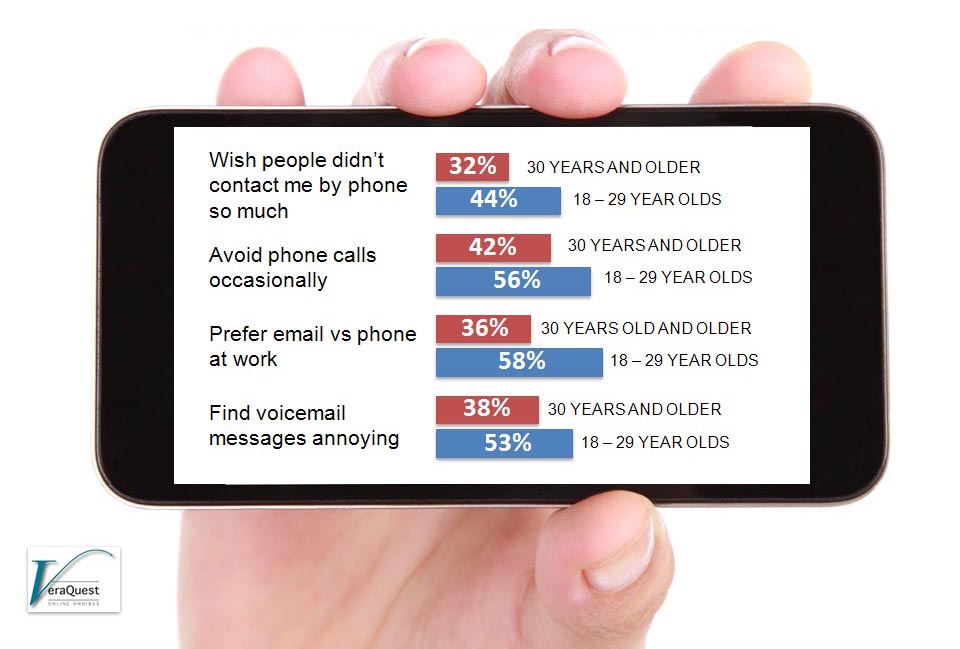I recently heard of some business colleagues who place their phones in the middle of the table when going out to lunch together. The first person who loses control and looks at his or her phone picks up the tab. I don’t do business lunches much anymore, but I can’t even imagine how much that little game would cost me.
That said, I don’t think I’m alone in my co-dependence on my phone, especially if I were twenty years younger and part of a generation that can’t remember a time before mobile technology was an integral part of the workplace. Truth be told, I too have changed over the years and now would rather have my cell phone ding to tell me I have a text than actually ring with someone’s “urgent” phone call. And this is particularly true among Millenials (ages 18-29), who shudder at the thought of even email.
According to the latest VeraQuest omnibus survey, our communication preferences – especially among Millenials but even Gen X and Yers – lean more these days toward writing rather than talking. In fact, my youngest daughter confided that in college she used to purposely let her voice mail fill up so my wife would give up trying to leave her voice mails. Mom has since learned how to text – where there’s a will there’s a way.
And, while my daughter may not be the norm of Americans as a whole, she certainly represents a new movement of younger Americans who veer more toward written contact than voice, as evidenced by our latest VeraQuest data:

- Wish people didn’t contact me by phone so much, but rather used other methods of communication, e.g., email, text, IM, etc. (32% of Americans aged 30+; 44% of 18-29 year olds)
- Avoid the phone occasionally because I’d rather someone contact me another way, e.g., email, text, etc. (42% of Americans aged 30+; 56% of 18-29 year olds)
- Prefer that people email me at work instead of call me (36% of Americans aged 30+; 58% of 18-29 year olds)
- Find retrieving voicemail messages annoying (38% of Americans ages 30+; 53% of 18-29 year olds)
In actuality, the vast majority of U.S. adults communicate both by voice technology (via phone) and by non-voice technology (via text, email or social media). But when pressed, U.S. adults as a whole much prefer to use the non-voice over voice by a rate of nearly 2:1. And, age is a major determinant of these findings as a majority of seniors ages 65+ say they prefer the phone, while 71% of those ages 18-29 prefer a non-voice method like text, social media or email. Even within the non-voice modes of communication, there is some clear generational differentiation; text and social media are much more strongly favored by the Millenials, while the Gen X-ers, baby boomers and even seniors are much more likely to rely on email.
Specifically in thinking through certain scenarios, U.S. adults overall appear to prefer the more tech-friendly (but impersonal) modes when in brief, casual conversations, and opt for the more traditional method of the telephone when they have either longer, more urgent or more intimate matters at hand. For example, voice technology is preferred when:
- Someone plans to initiate contact for an interaction that is likely to result in a “longer” conversation, with a lot of back-and-forth – e.g., catching-up with someone from the past (65% prefer voice vs 35% non-voice)
- Someone is going to initiate a moderate-length conversation, with expectations of some back-and-forth – e.g., discussing where and when to meet for dinner this weekend and who to invite (52% vs 39%)
- A friend or family member needs to get in touch for an urgent personal emergency (75% vs 21%)
- A colleague wants to get in touch for an urgent work emergency (64% vs 28%)
And, non-voice technology is preferred when:
- Someone wants to ask a quick question, with expectation of a brief reply – e.g., whether a flight is on time (29% prefer non-voice vs 65% voice)
- Someone wants to wish a happy birthday (35% vs 61%)
- Someone just wants to say “hi” (29% vs. 66%)
However, it is important to note that even in the scenarios above when the phone is preferred, it is favored much more strongly by the older age groups. And even when the non-voice modes are preferred, there is a big distinction within the generations between text and social media (which are much more commonly the predilection of the Millenials) and email (which is still much more widely utilized by anyone ages 40+).
What’s your preferred mode of communication? Voiced-based or text-based? And why?
 Zachary says
Zachary says
December 21, 2014 at 10:21 amGreat article! As I write I am filling up my voice mailbox on the phone that people aren’t supposed to use. I don’t mind voice as much as I do voiceMAIL (at age 33), from my dad (age 75), for example. The missed call is enough which is something someone my age likely takes for granted. I hang up on voicemail; when I leave one, it is to convey timely information.
But, to answer the question, it’s really a mixed bag. I send random hellos or horribly obscene one-liners to my friends by text. When I catch up with them once a week or so, it is voice.
Using Google Voice as heavily as I do, and with their integration of Voice into “Hangouts,” the line between SMS and social media becomes a bit more blurry, eh?